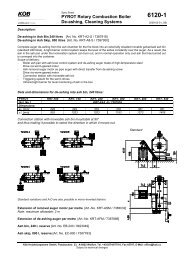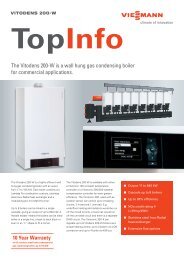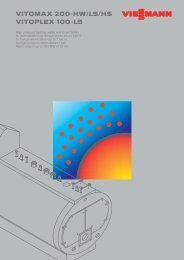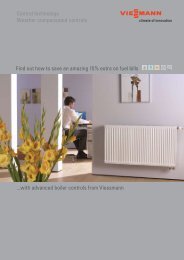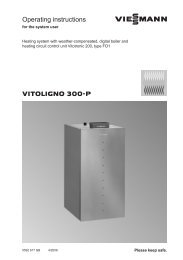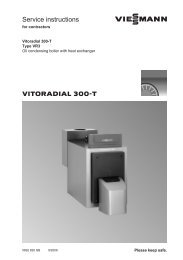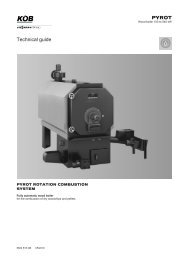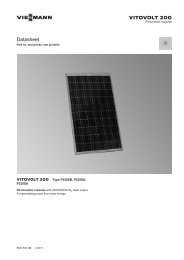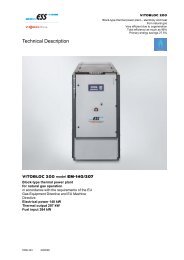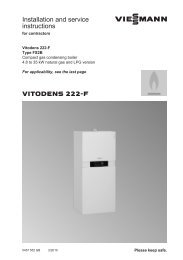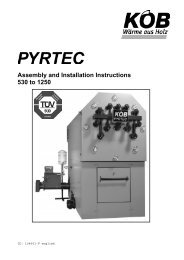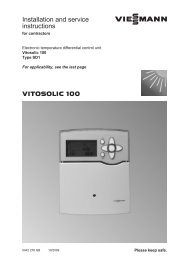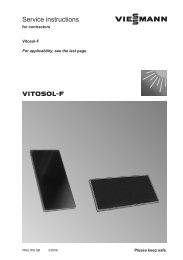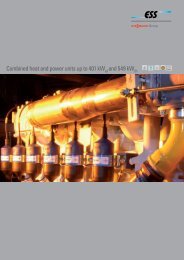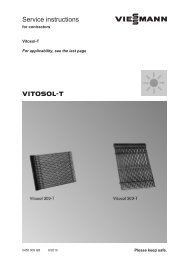Domestic Product Guide - Viessmann
Domestic Product Guide - Viessmann
Domestic Product Guide - Viessmann
You also want an ePaper? Increase the reach of your titles
YUMPU automatically turns print PDFs into web optimized ePapers that Google loves.
Control technology<br />
Controls<br />
<strong>Viessmann</strong> boilers have the added benefit of advanced control technology.<br />
<strong>Viessmann</strong> controls are easy to install,<br />
maintain and operate and benefit from fault<br />
logging and diagnostic systems. They switch<br />
easily between Winter and Summer settings<br />
and some models have useful short cuts,<br />
including holiday, party and economy<br />
settings. All Vitodens boilers will operate<br />
with <strong>Viessmann</strong> and non-<strong>Viessmann</strong><br />
external controls.<br />
Lambda Pro Control<br />
The Lambda Pro combustion controller works<br />
along side the burner to constantly monitor<br />
the air to gas ratio. Instead of the gas mix<br />
remaining fixed from installation, the mix<br />
is automatically adjusted to maintain the<br />
correct ratio – in a similar way to the fuel<br />
management system in your car engine.<br />
This also means that on-site commissioning<br />
time is reduced.<br />
The Lambda Pro is designed to work<br />
efficiently irrespective of the quality of the<br />
gas – a factor which will become more and<br />
more important as international gas supplies<br />
become less reliable.<br />
The control replaces the traditional gas valve<br />
and changing to LPG takes just a few seconds<br />
– with no replacement parts! The Lambda<br />
Pro is an integral component of the Vitodens<br />
200-W, Vitodens 222-F and Vitodens 242-F.<br />
Weather Compensation<br />
Weather compensation controls are a great,<br />
low cost way to make a boiler operate more<br />
efficiently. They can save up to 12% of annual<br />
fuel bills – that's on top of the big savings that<br />
you get from changing to a condensing boiler.<br />
The boiler is connected to a small sensor on<br />
the outside of the building. When the<br />
temperature changes outside, the boiler<br />
responds and starts to increase or decrease<br />
the radiator temperature, to compensate.<br />
This pro-active mechanism means that<br />
people inside the building won’t even notice<br />
that the temperature outside has changed.<br />
These constant small changes also mean that<br />
the boiler is able to operate at the minimum<br />
temperature required to keep the rooms<br />
warm. This keeps the return temperature as<br />
low as possible and a return temperature of<br />
57°C or less means the boiler can condense<br />
as it is designed to. Weather compensation<br />
maximises the condensing period of the boiler<br />
and results in significant fuel savings.



